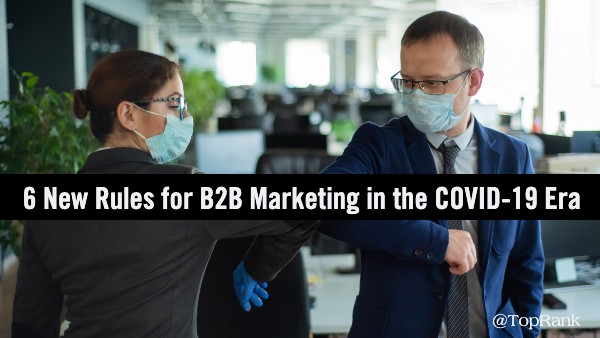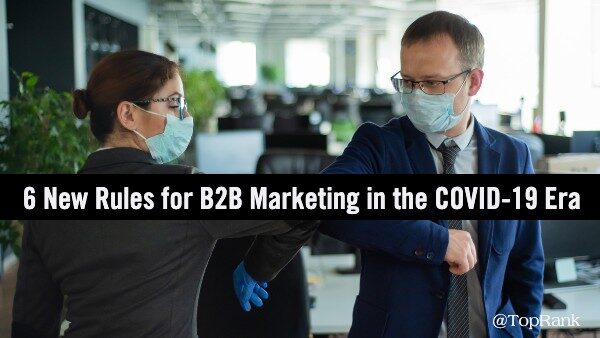
I was supposed to go to an Alanis Morissette concert this July. When the pandemic hit hard in March, I wasn’t ready to cancel my ticket yet. Surely, surely we would have it sorted in time for an outdoor concert four months from now. I held out hope. Then, in June, she rescheduled for July, 2021. And now I’m wondering if that will be enough time.
Isn’t it ironic?
Don’t you think?
All of which to say: This pandemic has been around for longer than we thought it would, and is looking to linger far longer than we would like. What seemed like a brief, surreal interlude to be gotten through has now become a reality to live with, at least for the time being.
As B2B marketers, we need to reassess how we are adapting our marketing to our buyers’ current situation. We’re no longer scrambling to cobble together short-term fixes — we need to be out of reaction mode and into strategic planning mode.
Our marketing agency has been helping clients revise their marketing plans for months now, from messaging and audience to tactics and measurement. Here are a few rules we’ve picked up that other marketers should follow:
6 New Rules for B2B Marketing in the COVID-19 Era
Rule #1: Always Be Relevant
Okay, this is less a NEW rule than a timely reminder. I’m sure most marketers who read our blog (as smart, skilled and beautiful as you are) don’t need to hear it. But just in case: You should never come to an audience without something of value.
Corollary: “Something of value” can not equal “Knowledge of how our product/solution can improve your life.”
People are distracted and stressed. They’re dealing with a new crisis every day. They’re spending way more time with their children than is psychologically healthy. And they have more content than ever before to occupy their free time. If you’re asking for their attention, you must reward it. Be entertaining, be useful, be both if you can. 'Be entertaining, be useful, be both if you can' in your #B2B content marketing, says @nitewrites. Share on X
After you deliver, then you can ask for a next step. But make sure your content is intrinsically valuable.
Rule #2: Encourage Interaction
The pandemic lifestyle is, to put it lightly, isolating. Who would have thought you could miss hearing co-workers rock in their chairs, play music a little too loud, or bump into you in the hallway? Most of us are craving social interaction.
If you’re used to broadcasting with your content, it’s time to consider how you can start conversations. How can you interact with your audience on a human level? How can you encourage them to interact with each other, too? Think how much your audience would value a lively, thought-provoking conversation with their colleagues and peers.
You can encourage interaction with content in a few easy ways:
- Host a LinkedIn Live chat
- Run a Twitter chat
- Sponsor a topic-themed chat in a video conferencing app
- Run an interactive webinar
In general, look for ways you can call out a subset of your audience and get them talking, both to each other and to your brand representatives. We can all use a little more social interaction right now.
Rule #3: Keep Messaging Empathetic
I don’t know about you, but I cringe every time I see an ad about something “going viral.” We are 6 months into a viral pandemic and marketers are still running ads about going viral! How can this be?
This is just one example of how completely innocuous messaging pre-COVID can seem tone-deaf now. Does your content have an anecdote about a dinner party with 15 people? Does your header image feature a crowd of people? Are you talking about “going into the office” or “thinking about this on your commute?” If so, you’re alienating your audience.
Not every piece of content has to be about the pandemic, or being nostalgic for the world that once was. But there needs to be a baseline of empathy: Working from home, social distancing, and mask-wearing are all facts of everyday life.
Rule #4: Experiment with Formats
In the time before the pandemic, we all spent hours looking at screens every day. It’s just there were different screens, in different environments. It was easier to differentiate between the office and home, work and play. Now, our surroundings are homogenous throughout the day — and the content we consume feels same-y, too.
Think about content fatigue as you plan your calendar. Is your audience looking for another wall of text? Do they want to look at another grid of talking heads?
Our agency is finding more success right now with multimedia, interactive content. Our B2B Influencer Marketing report is an example. The content includes case studies, influencer participation, and original research, presented in an animated, dynamic way.
Essentially, keep in mind that idea of efficiently delivering value. Can your blog post be a quick video or audio interview instead? And can that video be five minutes long instead of 10? Can your blog post be a quick video or audio interview instead? And can that video be five minutes long instead of 10? says @nitewrites. Share on X
Rule #5: Collaborate on Content
For me, one of the stranger elements of pandemic life is learning how similar I am to everyone else. I had an urge to do puzzles in March — all the stores were sold out. I wanted to make bread in April — the stores ran out of flour. In May, everyone bought bikes.
Right now, every B2B business is missing their trade shows and in-person demos. So most of them are doubling down on content. The best way to differentiate your content is to bring your audience voices they can’t hear anywhere else.
Co-create content with influencers. Feature subject matter experts in your organization. Tap your current and prospective customers to get their take. The more voices you can bring to your content, the more it will stand out to your audience.
Rule #6: Re-Align Measurement with Current Goals
Per rule #1, people are less interested in promotional content right now. Businesses may have put their purchasing plans on hold, or at least tightened budgets. Marketing’s chief goal right now is likely to be establishing brand credibility, creating thought leadership content, and building relationships for the future.
As your goals change, your measurement must change as well. You can’t measure an awareness campaign in SQLs, or relationship-building in number of demo requests received. That doesn’t mean giving up on measurement or accountability — it just means making the metrics match your goals. For example, you could measure:
- Brand share of voice
- Email/Blog subscribers
- Social media audience/interactions
- Content consumption metrics (time on page, scroll depth, links clicked)
- Content resonance (backlinks and social shares)
How New Are These Rules?
So here’s the $100,000 (adjusted for inflation) question: At what point should you stop producing relevant, interactive, empathetic, dynamic and collaborative content? When can you heave a sigh of relief, stop listening to your audience, and start broadcasting promotional messages?
When you put it that way, it’s obvious: These rules are best practices for content no matter what’s going on in the world. The pandemic didn’t create the need for these rules; it just amplified how crucial they are. Back in January, we might have had the luxury of ignoring one or more of them. Now we have the joyous necessity of being forced to do better.
And that’s the good news: Making your marketing better for the pandemic will make you a better marketer now and for whatever comes next.
Need help creating content? We’re here for you.



